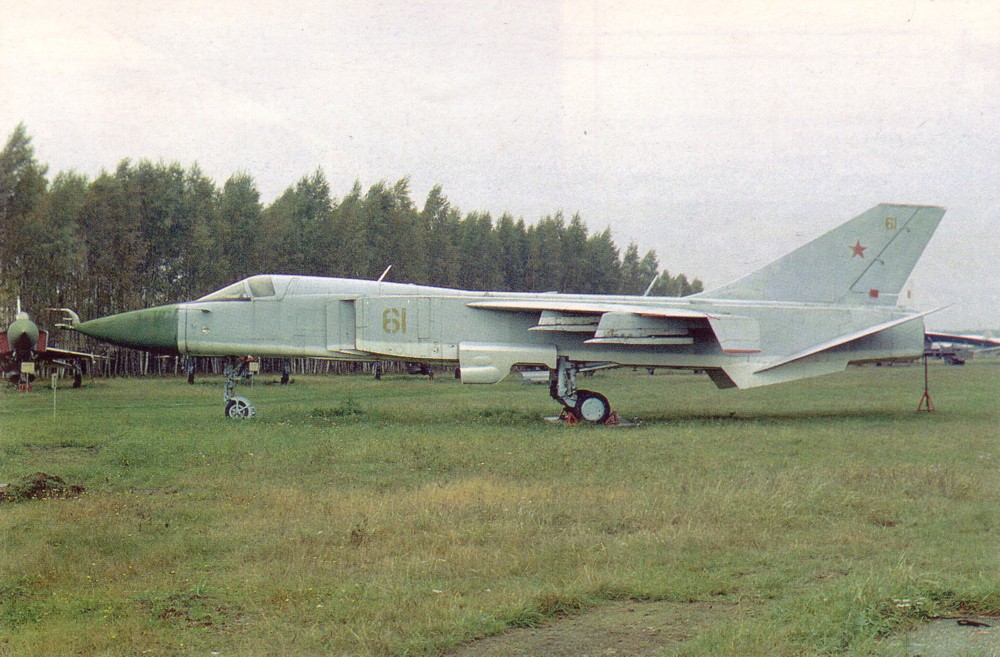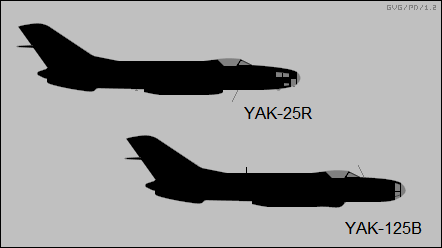|
Vozzhayevka (air Base)
Vozzhayevka (also Vozzhayevka Northeast (US)) is an air base in Amur Oblast, Russia located about 100 km southeast of Blagoveshchensk. It is a medium-sized air base located near an SS-11 missile field at Svobodnyy. During the 1980s it was one of 17 airfields hosting the Soviet Union's tactical reconnaissance aircraft regiments.STATUS OF SOVIET TACTICAL RECONNAISSANCE FORCES USSR/EASTERN EUROPE/AFGHANISTAN(SANITIZED) March 22, 1984, CIA-RDP84T00491R000101240001-9, Central Intelligence Agency, Washington, DC. Units stationed at Vozzhayevka include: * 293 ORAP (293rd Independent Aviation Reconnaissance Regiment) and 56 APIB (56rd Fighter-Bomber Aviation Regiment) flying |
Vozzhayevka
Vozzhayevka (also Vozzhayevka Northeast (US)) is an air base in Amur Oblast, Russia located about 100 km southeast of Blagoveshchensk. It is a medium-sized air base located near an SS-11 missile field at Svobodnyy. During the 1980s it was one of 17 airfields hosting the Soviet Union's tactical reconnaissance aircraft regiments.STATUS OF SOVIET TACTICAL RECONNAISSANCE FORCES USSR/EASTERN EUROPE/AFGHANISTAN(SANITIZED) March 22, 1984, CIA-RDP84T00491R000101240001-9, Central Intelligence Agency, Washington, DC. Units stationed at Vozzhayevka included the 293rd Independent Reconnaissance Aviation Regiment (293 ORAP) and the 56th Aviation Regiment of Fighter-Bombers (56 APIB) flyi ... [...More Info...] [...Related Items...] OR: [Wikipedia] [Google] [Baidu] |
Sakhalin
Sakhalin ( rus, Сахали́н, r=Sakhalín, p=səxɐˈlʲin; ja, 樺太 ''Karafuto''; zh, c=, p=Kùyèdǎo, s=库页岛, t=庫頁島; Manchu: ᠰᠠᡥᠠᠯᡳᠶᠠᠨ, ''Sahaliyan''; Orok: Бугата на̄, ''Bugata nā''; Nivkh: Yh-mif) is the largest island of Russia. It is north of the Japanese archipelago, and is administered as part of the Sakhalin Oblast. Sakhalin is situated in the Pacific Ocean, sandwiched between the Sea of Okhotsk to the east and the Sea of Japan to the west. It is located just off Khabarovsk Krai, and is north of Hokkaido in Japan. The island has a population of roughly 500,000, the majority of which are Russians. The indigenous peoples of the island are the Ainu, Oroks, and Nivkhs, who are now present in very small numbers. The Island's name is derived from the Manchu word ''Sahaliyan'' (ᠰᠠᡥᠠᠯᡳᠶᠠᠨ). Sakhalin was once part of China during the Qing dynasty, although Chinese control was relaxed at times. Sakhalin was l ... [...More Info...] [...Related Items...] OR: [Wikipedia] [Google] [Baidu] |
Soviet Frontal Aviation
The Soviet Union,. officially the Union of Soviet Socialist Republics. (USSR),. was a List of former transcontinental countries#Since 1700, transcontinental country that spanned much of Eurasia from 1922 to 1991. A flagship communist state, it was nominally a Federation, federal union of Republics of the Soviet Union, fifteen national republics; in practice, both Government of the Soviet Union, its government and Economy of the Soviet Union, its economy were highly Soviet-type economic planning, centralized until its final years. It was a one-party state governed by the Communist Party of the Soviet Union, with the city of Moscow serving as its capital as well as that of its largest and most populous republic: the Russian Soviet Federative Socialist Republic, Russian SFSR. Other major cities included Saint Petersburg, Leningrad (Russian SFSR), Kyiv, Kiev (Ukrainian Soviet Socialist Republic, Ukrainian SSR), Minsk (Byelorussian Soviet Socialist Republic, Byelorussian SSR), Tas ... [...More Info...] [...Related Items...] OR: [Wikipedia] [Google] [Baidu] |
Soviet Air Force Bases
The Soviet Union,. officially the Union of Soviet Socialist Republics. (USSR),. was a transcontinental country that spanned much of Eurasia from 1922 to 1991. A flagship communist state, it was nominally a federal union of fifteen national republics; in practice, both its government and its economy were highly centralized until its final years. It was a one-party state governed by the Communist Party of the Soviet Union, with the city of Moscow serving as its capital as well as that of its largest and most populous republic: the Russian SFSR. Other major cities included Leningrad (Russian SFSR), Kiev (Ukrainian SSR), Minsk ( Byelorussian SSR), Tashkent (Uzbek SSR), Alma-Ata (Kazakh SSR), and Novosibirsk (Russian SFSR). It was the largest country in the world, covering over and spanning eleven time zones. The country's roots lay in the October Revolution of 1917, when the Bolsheviks, under the leadership of Vladimir Lenin, overthrew the Russian Provisional Government th ... [...More Info...] [...Related Items...] OR: [Wikipedia] [Google] [Baidu] |
Astrakhan
Astrakhan ( rus, Астрахань, p=ˈastrəxənʲ) is the largest city and administrative centre of Astrakhan Oblast in Southern Russia. The city lies on two banks of the Volga, in the upper part of the Volga Delta, on eleven islands of the Caspian Depression, 60 miles (100 km) from the Caspian Sea, with a population of 475,629 residents at the 2021 Census. At an elevation of below sea level, it is the lowest city in Russia. Astrakhan was formerly the capital of the Khanate of Astrakhan (a remnant of the Golden Horde), and was located on the higher right bank of the Volga, 7 miles (11 km) from the present-day city. Situated on caravan and water routes, it developed from a village into a large trading centre, before being conquered by Timur in 1395 and captured by Ivan the Terrible in 1556. In 1558 it was moved to its present site. The oldest economic and cultural center of the Lower Volga, [...More Info...] [...Related Items...] OR: [Wikipedia] [Google] [Baidu] |
Ilyushin Il-76
The Ilyushin Il-76 (russian: Илью́шин Ил-76; NATO reporting name: Candid) is a multi-purpose, fixed-wing, four-engine turbofan strategic airlifter designed by the Soviet Union's Ilyushin design bureau. It was first planned as a commercial freighter in 1967, as a replacement for the Antonov An-12. It was designed to deliver heavy machinery to remote, poorly served areas. Military versions of the Il-76 have been widely used in Europe, Asia and Africa, including use as an aerial refueling tanker or command center. The Il-76 has seen extensive service as a commercial freighter for ramp-delivered cargo, especially for outsized or heavy items unable to be otherwise carried. It has also been used as an emergency response transport for civilian evacuations as well as for humanitarian aid and disaster relief around the world. Due to its ability to operate from unpaved runways, it has been useful in undeveloped areas. Specialized models have also been produced for aerial fir ... [...More Info...] [...Related Items...] OR: [Wikipedia] [Google] [Baidu] |
Sukhoi Su-24
The Sukhoi Su-24 ( NATO reporting name: Fencer) is a supersonic, all-weather attack aircraft developed in the Soviet Union. The aircraft has a variable-sweep wing, twin-engines and a side-by-side seating arrangement for its crew of two. It was the first of the USSR's aircraft to carry an integrated digital navigation/attack system. It remains in service with the Russian Air Force, Syrian Air Force, Ukrainian Air Force, Algerian Air Force and various other air forces to which it was exported. Development Background One of the conditions for accepting the Sukhoi Su-7B into service in 1961 was the requirement for Sukhoi to develop an all-weather variant capable of precision air strikes. Preliminary investigations with ''S-28'' and ''S-32'' aircraft revealed that the basic Su-7 design was too small to contain all the avionics required for the mission. OKB-794 (later known as Leninets) was tasked with developing an advanced nav/attack system, codenamed ''Puma'', which would be ... [...More Info...] [...Related Items...] OR: [Wikipedia] [Google] [Baidu] |
Mikoyan-Gurevich MiG-15
The Mikoyan-Gurevich MiG-15 (russian: Микоя́н и Гуре́вич МиГ-15; USAF/DoD designation: Type 14; NATO reporting name: Fagot) is a jet fighter aircraft developed by Mikoyan-Gurevich for the Soviet Union. The MiG-15 was one of the first successful jet fighters to incorporate swept wings to achieve high transonic speeds. In aerial combat during the Korean War, it outclassed straight-winged jet day fighters, which were largely relegated to ground-attack roles. In response to the MiG-15’s appearance and in order to counter it, the United States Air Force rushed the North American F-86 Sabre to Korea.Thompson, Warren"Sabre: The F-86 in Korea."''Flight Journal'', December 2002. Retrieved: 30 June 2011. When refined into the more advanced MiG-17, the basic design would again surprise the West when it proved effective against supersonic fighters such as the Republic F-105 Thunderchief and McDonnell Douglas F-4 Phantom II in the Vietnam War of the 1960s. The MiG-15 ... [...More Info...] [...Related Items...] OR: [Wikipedia] [Google] [Baidu] |
Yakovlev Yak-28
The Yakovlev Yak-28 (russian: Яковлев Як-28) is a swept wing, turbojet-powered combat aircraft used by the Soviet Union. Produced initially as a tactical bomber, it was also manufactured in reconnaissance, electronic warfare, interceptor, and trainer versions, known by the NATO reporting names Brewer, Brewer-E, Firebar, and Maestro respectively. Based on the Yak-129 prototype first flown on 5 March 1958, it began to enter service in 1960. Design and development The Yak-28 was firstTaylor 1976, pp. 520–521. seen by the West at the Tushino air show in 1961. Western analysts initially believed it to be a fighter rather than an attack aircraft—and a continuation of the Yak-25M—and it was designated "Flashlight". After its actual role was realized, the Yak-28 bomber series was redesignated "Brewer". The Yak-28 had a large mid-mounted wing, swept at 45 degrees. The tailplane set halfway up the vertical fin (with cutouts to allow rudder movement). Slats were fitted ... [...More Info...] [...Related Items...] OR: [Wikipedia] [Google] [Baidu] |
Yakovlev Yak-25
The Yakovlev Yak-25 ( NATO designation Flashlight-A/Mandrake) was a swept wing, turbojet-powered interceptor and reconnaissance aircraft built by Yakovlev and used by the Soviet Union. Design and development The Yak-25 originated from a need for long-range Interceptor aircraft to protect the USSR's northern and eastern territory. The specification for a two-seat, twin-engine jet fighter and a related reconnaissance aircraft was issued by Joseph Stalin on 6 August 1951. Yak-120 Yakovlev began developing a two-seat, twin-engine patrol interceptor, designated the Yak-120 by the design bureau, in 1951. It received official authorization by a directive of the Council of Ministers on 10 August of that year. In a break from previous Yakovlev designs, the Yak-120's thin, mid-set wings were swept back at a 45 degree angle with large two-section flaps. To provide more directional stability, a ventral fin was attached below the swept cruciform tail. The aircraft was powered by two Miku ... [...More Info...] [...Related Items...] OR: [Wikipedia] [Google] [Baidu] |
Mikoyan-Gurevich MiG-17
The Mikoyan-Gurevich MiG-17 (russian: Микоян и Гуревич МиГ-17; NATO reporting name: Fresco) is a high-subsonic fighter aircraft produced in the Soviet Union from 1952 and was operated by air forces internationally. The MiG-17 was license-built in China as the Shenyang J-5 and Poland as the PZL-Mielec Lim-6. The MiG-17 is still being used by the North Korean air force in the present day and has seen combat in the Middle East and Asia. The MiG-17 was an advanced modification of the MiG-15 aircraft produced by the Soviet Union during the Korean War. Production of the MiG-17 was too late for use in that conflict and was first used in the Second Taiwan Strait Crisis in 1958. While the MiG-17 was designed to shoot down slower American bombers, it showed surprising success when used by North Vietnamese pilots to combat American fighters and fighter-bombers during the Vietnam War, nearly a decade after its initial design. This was due to the MiG-17 being more agile and ... [...More Info...] [...Related Items...] OR: [Wikipedia] [Google] [Baidu] |
Tupolev Tu-4
The Tupolev Tu-4 (russian: Туполев Ту-4; NATO reporting name: Bull) is a piston-engined Soviet strategic bomber that served the Soviet Air Force from the late 1940s to mid-1960s. It was reverse-engineered from the American Boeing B-29 Superfortress. Design and development Toward the end of World War II, the Soviet Union saw the need for a strategic bombing capability similar to that of the United States Army Air Forces. The Soviet VVS air arm had the locally designed Petlyakov Pe-8 four-engined "heavy" in service at the start of the war, but only 93 had been built by the end of the war and the type had become obsolete. The U.S. regularly conducted bombing raids on Japan, from distant Pacific forward bases using B-29 Superfortresses. Joseph Stalin ordered the development of a comparable bomber. The U.S. twice refused to supply the Soviet Union with B-29s under Lend Lease. [...More Info...] [...Related Items...] OR: [Wikipedia] [Google] [Baidu] |


_(2).jpg)


.jpg)

